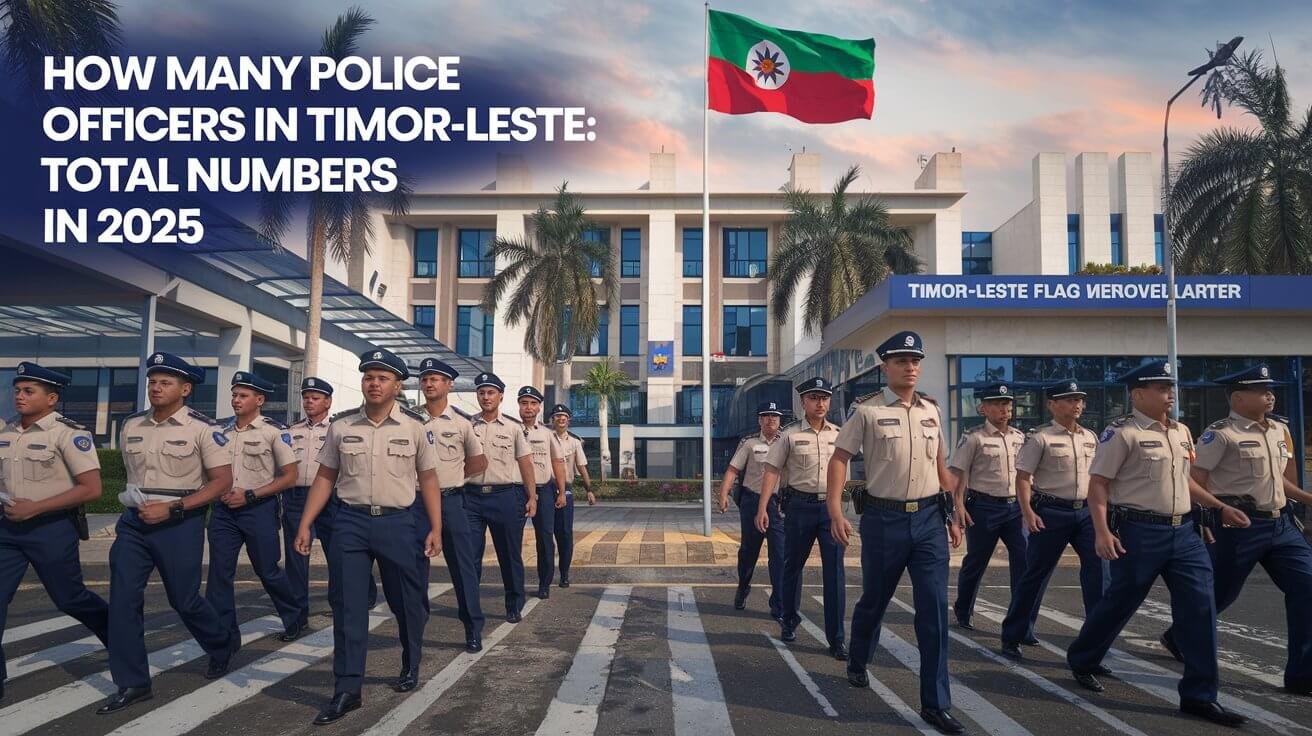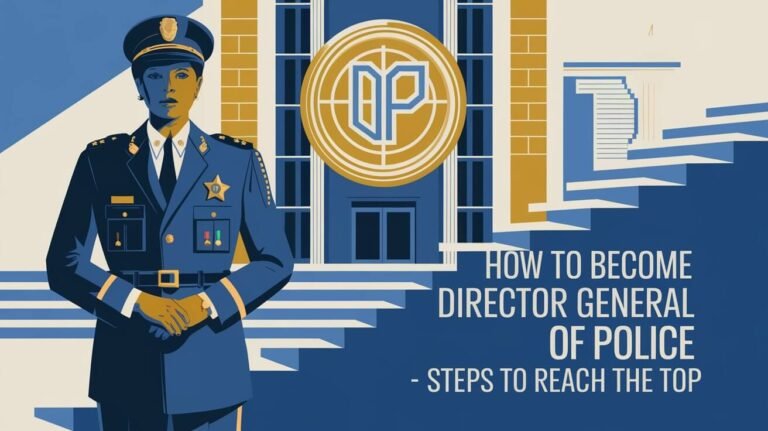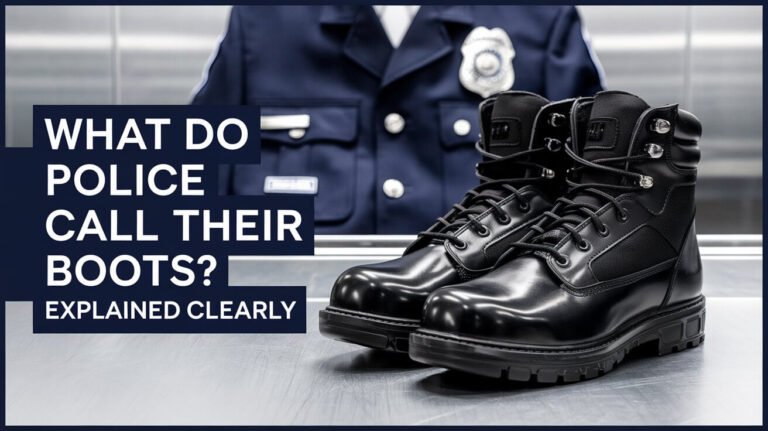How Many Police Officers Timor-Leste: Total Numbers In 2025

In Timor-Leste, a lot of police officers work hard to keep everyone safe. There are 1,227 UN Police officers and 738 Community Police officers. They help keep the peace and follow the law.
Police officers from many countries like Malaysia, Portugal, and Bangladesh work here. This makes the police force in Timor-Leste very diverse and international.
The police in Timor-Leste do many important jobs. They stop and solve crimes and keep things calm. Having about 1,200 UN Police officers from over 40 countries helps a lot. This international help makes the police force stronger.
Police Force Size in Timor-Leste
The size of the police force in Timor-Leste is key to keeping the country safe. With a population of about 1.2 million, the number of police officers is important. There are 4,165 active officers, which means about 1 police officer for every 300 people.
This ratio helps us see how many police officers are in each area. Most officers are in Dili, the capital city. This makes sure the police can handle the security needs of the people well.
Current Active Officers
The 4,165 active officers in Timor-Leste work hard to keep the peace. They also help the community. The size of the police force is shaped by the country’s history, geography, and culture.
Officer-to-Population Ratio
The ratio of police officers to people in Timor-Leste is a key measure. A higher ratio means more police, which can lead to better security and fewer crimes. With a ratio of 1:300, Timor-Leste has a strong police presence.
Distribution Across Districts
How police officers are spread out across districts is very important. Most officers are in Dili, but others are in the other 12 districts. Here’s a table showing where the police are:
| District | Number of Officers |
|---|---|
| Dili | 1,500 |
| Aileu | 200 |
| Ainaro | 150 |
| Baucau | 300 |
| Bobonaro | 250 |
| Cova Lima | 200 |
| Ermera | 150 |
| Lautem | 200 |
| Liquica | 250 |
| Manatuto | 150 |
| Manufahi | 200 |
| Oecusse | 150 |
| Viqueque | 200 |
Size of the police force in Timor-Leste is vital for safety. The number of officers and how they are spread out are key to understanding their role.
History of Timor-Leste National Police
The history of the Timor-Leste National Police is deeply connected to the country’s fight for freedom. It gained independence from Indonesia in 2002. The United Nations was key in setting up and growing the police force, helping with training, gear, and support.
The Timor-Leste National Police started in May 2002. Its main job was to keep the country safe and order. The force has grown a lot, aiming to be professional and answerable to the people. Important moments in the police’s history include:
- 2002: The Timor-Leste National Police was established, with a initial strength of 1,500 officers.
- 2003: The police faced big challenges, leading to a drop in public trust.
- 2012: The United Nations Police left Timor-Leste, and the national police took over.
Now, the Timor-Leste National Police is vital for keeping peace in the country. The force has worked hard to win back the community’s trust. Its journey shows how important a reliable and accountable police service is.
Police Force Structure and Divisions
The police force in Timor-Leste works hard to keep everyone safe. The Timor-Leste National Police (PNTL) has different teams. These include the Rapid Intervention Unit, Border Patrol Unit, and Criminal Investigation Unit.
Some important special units in the PNTL are:
- Rapid Intervention Unit: responds to emergencies
- Border Patrol Unit: keeps the borders safe
- Criminal Investigation Unit: solves crimes and gathers evidence
The PNTL also has support teams like the Police Training Center and the Ministry of the Interior. These teams help the police do their job well.
| Unit | Description |
|---|---|
| Rapid Intervention Unit | Responds to emergency situations |
| Border Patrol Unit | Ensures border security |
| Criminal Investigation Unit | Investigates crimes and collects evidence |
Police force in Timor-Leste is always getting better. The PNTL is working hard to grow and improve. They aim to hire more officers and give them the training they need to help the community.
Training and Recruitment Process
The Timor-Leste police force trains its officers well. They learn about law enforcement, human rights, and community policing. This training helps them do their jobs well.
To join the Timor-Leste police, candidates go through tests and interviews. Recently, 250 new recruits started their training. This is a big step for the police force.
Some important training programs include:
- A computer-based training on “First Responders to a Crime Scene” by the National Police of Timor-Leste. It teaches officers what to do at a crime scene.
- A program by UNODC, with help from Australia and the United States. It aims to improve law enforcement skills in Timor-Leste.
Timor-Leste police also work internationally. 17 PNTL officers are ready for UN missions. They have worked in Kosovo and Guinea-Bissau. This shows their commitment to global cooperation and peacekeeping.
Police Infrastructure and Resources
The police in Timor-Leste are key to keeping the country safe. They face challenges due to limited resources and equipment. Yet, they are striving to improve and serve the community better.
The police use various tools like guns, cars, and radios to do their job. They are also adding technology, like computers and cameras, to boost safety and efficiency.
Some important tools for the police include:
- Firearms and ammunition
- Vehicles, including cars and motorcycles
- Communication devices, such as radios and phones
- Computer systems and software
- Surveillance cameras and monitoring equipment
Building up the police’s resources is vital for their success. With support from international groups, they aim to enhance their abilities and serve the community more effectively.
| Equipment/Resource | Description |
|---|---|
| Firearms | Used for self-defense and to maintain law and order |
| Vehicles | Used for patrols, transportation, and emergency response |
| Communication devices | Used for communication and coordination among police units |
| Computer systems | Used for data management, investigation, and intelligence gathering |
| Surveillance cameras | Used for monitoring and surveillance of public areas |
Collaboration with International Police Forces
The National Police of Timor-Leste works with international police to get better at their job. They share training, equipment, and help with operations. This also includes sharing information.
Some examples of this teamwork are:
- About 500-600 police from Australia, Malaysia, Portugal, and New Zealand helped in Dili, Timor-Leste.
- 17 PNTL officers got certified for UN missions. Ten went to Kosovo, and two to Guinea-Bissau.
- The Portuguese National Republican Guard and Malaysian police used special tactics for big crowds.
This partnership has made the police in Timor-Leste stronger. They can now handle security threats better. Working together shows how important it is to coordinate well, both locally and internationally.
Budget Allocation for Law Enforcement
The budget for law enforcement in Timor-Leste is key to the country’s safety. With a small budget, the government must choose wisely to keep law enforcement effective. The yearly spending on law enforcement is about $10 million, a big part of the country’s budget.
Money goes to different areas like the police, courts, and prisons. To make law enforcement better, the government is boosting the PNTL’s skills. This includes training and giving them the right tools and support.
Annual Expenditure
Every year, Timor-Leste spends a lot on keeping its people safe. The money helps the PNTL with salaries, gear, and training. The government wants to give more money to the police to keep the country safe and stable.
Resource Distribution
Law enforcement funds are spread out among different groups. The PNTL gets most of it to run their operations, train, and buy equipment. The government is also improving the courts and prisons to make justice and law enforcement better in Timor-Leste.
Police Response and Crime Statistics
Timor-Leste struggles with its police response and crime rates. It’s a hotspot for human trafficking, affecting children and young adults. In the capital, young people often face sexual exploitation.
The police in Timor-Leste have limited resources. They face big challenges in fighting crime. Here are some key crime issues in the country:
- Human trafficking, with children and young women being exploited
- Trade of illegal weapons, with the national police force being identified as a primary source of undocumented weapons
- Counterfeit products, including Tais products, impacting the traditional weaving industry
- Tobacco smuggling, with processed cigarettes and cut tobacco entering the country illegally
To tackle these problems, the police are boosting patrols and improving investigations. Yet, crime rates in Timor-Leste are high. The police aim to make the country safer for everyone.
Community Policing Initiatives
In Timor-Leste, community policing is making a big difference. It’s all about improving safety and gaining trust from the people. Programs focus on reaching out to the community. They teach about crime prevention and human rights.
Some numbers show how well these efforts are working. In 2018, almost all people and leaders said they trust the police. Also, 77% of the public saw the police getting better at their job compared to last year.
These community efforts also include partnerships with the police and the public. They work together to solve security problems. Some examples are:
- Neighborhood watch programs, where people report odd activities to the police.
- Community Policing Councils (CPCs), made up of volunteers from suco councils.
These steps show the National Police of East Timor’s dedication to community policing. They’ve helped make the community safer and more trusting of the police.
| Year | Trust in Police | Perceived Improvement in Police Performance |
|---|---|---|
| 2018 | 99% | 77% |
| 2015 | NA | NA |
Challenges Faced by Timor-Leste Police
The Timor-Leste police struggle to keep the country safe. One big problem is overcrowded prisons. For example, Beçora Prison in Dili can hold 290 people but has 455. This shows the need to tackle crime’s root causes and lower detention numbers.
Another issue is the lack of transparency and accountability. Police brutality and human rights abuses have happened but haven’t been solved. The police must gain the community’s trust, mainly in rural areas, and be responsible for their actions.
Some of the challenges faced by the Timor-Leste police include:
- Limited resources and infrastructure
- Lack of training and equipment
- High crime rates
- Difficulty in building trust with the community
The police are trying to overcome these hurdles. They aim to increase their presence in rural areas and improve crime response. Yet, more efforts are needed to ensure the police can keep the country safe and protect citizens’ rights.
Future Development Plans
The Timor-Leste police force is working hard to meet its future goals. They aim to have more police officers and better facilities. They want to attract more qualified people to join the force.
This will help them serve the community better and keep the area safe.
Some key plans include:
- Expanding training programs to enhance the skills and capabilities of police officers
- Improving infrastructure, including the construction of new police stations and the renovation of existing ones
- Increasing the use of technology, such as forensic equipment and communication systems, to support police operations
The police force is dedicated to meeting these goals. They want to improve their services for the community. Their plans support the country’s growth and stability.
They are also building partnerships with countries like Australia and Portugal. This will help them get training and expertise. With these efforts, the Timor-Leste police is set to grow and support the country’s future.
| Initiative | Objective | Timeline |
|---|---|---|
| Expanding training programs | Enhance skills and capabilities of police officers | 2023-2025 |
| Improving infrastructure | Provide better facilities and equipment for police operations | 2023-2026 |
| Increasing use of technology | Support police operations and improve response times | 2023-2027 |
Last Thoughts
As we wrap up our look at the Timor-Leste police, it’s clear they face big challenges. These include limited resources and concerns about misconduct. But, with a focus on community policing, accountability, and working with other countries, things are looking up.
The UN’s role in helping the police shows how important a clear plan and strong checks are. This ensures the Timorese police act with professionalism and integrity. By improving how they handle themselves and addressing abuse claims, the government can win back the public’s trust.
As the Timor-Leste police grow, they’ll need help from the world. Support in training, gear, and building will be key. A detailed look at what they do well and what they don’t will help them improve.
Timor-Leste police can build stronger ties with the community. By being open, quick to respond, and respecting human rights, they can become a key part of Timor-Leste’s democracy.
Common Questions
How many police officers are there in Timor-Leste?
As of 2018, Timor-Leste has 4,165 active police officers.
What is the officer-to-population ratio in Timor-Leste?
In Timor-Leste, there’s about 1 police officer for every 300 people. The country has around 1.2 million people.
How is the National Police of East Timor distributed across the country?
The National Police of East Timor covers 13 districts. Most officers are in Dili, the capital city.
When was the National Police of East Timor established?
The National Police of East Timor started in May 2002. The United Nations set it up to keep the country safe.
What are the special units within the National Police of East Timor?
The National Police of East Timor has special units. These include the Police Reserve Unit, the Border Patrol Unit, and the Rapid Intervention Unit.
How does the National Police of East Timor recruit and train its officers?
The police force recruits through tests and interviews. They train on law enforcement, human rights, and community policing.
What kind of equipment and resources does the National Police of East Timor have?
The police use firearms, vehicles, and communication devices. They’re also using technology like computer systems and surveillance cameras.
How does the National Police of East Timor collaborate with international police forces?
The National Police of East Timor works with international forces. They share training, equipment, and intelligence to improve safety.
What is the budget allocation for law enforcement in Timor-Leste?
Law enforcement in Timor-Leste gets a small part of the budget. The police spend about $10 million a year, which is a big part of the country’s budget.
How does the National Police of East Timor respond to crime in Timor-Leste?
Fighting crime is hard for the police in Timor-Leste. They face many challenges, including limited resources and high crime rates. They’re working to do better, like increasing patrols and improving investigations.
What community policing initiatives has the National Police of East Timor implemented?
The police are trying to make the community safer. They’re doing outreach, forming safety partnerships, and starting neighborhood watch programs.
What are the main challenges faced by the National Police of East Timor?
The police face many challenges. These include limited resources, lack of training, and high crime rates. They also struggle to gain trust, mainly in rural areas.
What are the future development plans for the National Police of East Timor?
The police have plans for the future. They aim to grow their numbers and improve their infrastructure. They also want to enhance their training and presence in rural areas.






